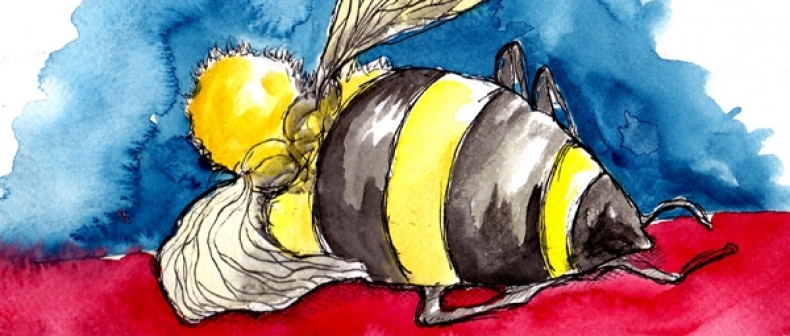
By Samantha Bennett
To make sense of the following, you will need to read Parts One and Two of this Beedazzle.
The Queen is dead. The most probable scenario is that she flew out to mate and was eaten by a bird. This leaves us with a monarch-less hive. A few worker bees have taken over, grown wombs, and begun laying unfertilized eggs themselves, but the quantities are much smaller, and they will all be drones (males), who are not capable of much in the way of helping out. The hive cannot grow enough to survive the winter.
A queen has multiple uteruses ( uteri?), in which she stores the semen of many drones. She can lay up to 2000 eggs a day, and in three weeks the first bee batch will be born. She keeps at it until the hive is anywhere from 20 to 40 thousand strong.
In the summer months, a bee’s life expectancy is about 4 weeks. When our ladies are born (and 90 percent of them are gals), they are nurse bees for the first week or so, which makes them essentially maids and nannies. They help the new furries to be born, removing the sticky stuff from their wings and antennae. They clean up around the combs. The second week they become worker bees. In this stage they take the pollen and nectar brought in, mix it and turn it into comb.
Some of them form the Queen’s entourage, following behind her as she drops each egg into the dead centre of each cell, and capping it with a honey mixture, keeping it safe, and allowing for incubation. The worker bee can be seen just outside the hive taking her first practice flights, before she moves into her fourth and final stage: a forager. These bees fly back and forth all day, carting nectar and pollen in the hairs on their body and the bottom of their feet. Tiny amounts. All day. Every day.
We need a queen and we need one fast. Bryan makes an emergency call to the McGill campus in St Anne-De- Bellevue, where they have an aviary. We drive out one balmy Sunday afternoon to meet Branislaw, a mellow, middle-aged Russian in charge of the operation. He cannot spare a queen, but generously offers a foot long chunk of drippy comb, full of soon-to-be-born bees, and still attached to the board, so all we need do is lower the board into our hive alongside the comb-full boards already there, giving our gals re-enforcements and food. Our hope is that they will begin to build a queen cell, essentially making their own queen. This is done by feeding the young Queen larvae royal jelly, a protein-rich secretion from the glands on the heads of worker bees. All bee larvae are fed this for a few days after hatching, but it is only Her Majesty who is fed it exclusively, resulting in a sexually mature female, our very own Queen.
We realize a few days later that the problem with this plan is time, something of which we are increasingly short. By the time Her Highness is born, matures, mates, lays and produces, it will be mid-August, and this is dangerously close to Autumn, which is perilously near Winter. We buy a Queen from an operation off-island. Like the first time, she is in a tiny cage with a stopper of marshmallow at one end. We lower her on a wire into the hive, knowing it will take a few days for the gals to eat their way into her, and for her to chew her way out, giving everyone time to get used to the other’s scent. If we just drop her in un-announced she will be leapt upon and slain. When we open the hive we are pleased to see quite a bit of comb, as well as the unmistakable shape of a queen cell. We know that if the queen finds this cell she will sting it to death. There can be only one. We leave the queen cell intact as a fail-safe. If the existing queen is also eaten by a bird, we have the soon-to-be-born queen to fall back upon.
Bryan and I gaze into our hive, awe-struck as always by their industry, their gentleness with us. Gone are the veils, the gloves. We are in sandals and short sleeves, our furry friends buzzing indulgently around us. Some beekeepers swear the bees know them, respond to them. I cannot yet attest to this, but my feelings of protective warmth endure. I badly want them to make it. Stay tuned.
________
Samantha is a writer and comic living in Montreal. She can be reached at samstress3@gmail.com. She cheerfully encourages questions and comments.
For more, follow us on Twitter at @TorontoStandard and subscribe to our newsletter.











